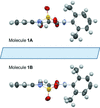issue contents
January 2020 issue

Cover illustration: The conformational flexibilities of two new amidophosphoester structures with an (O)2P(O)(N) skeleton and 118 analogous structures from the Cambridge Structural Database were studied. See Vahdani Alviri, Pourayoubi, Abdul Salam, Necas, van der Lee, Chithran & Damodaran [Acta Cryst. (2020), C76, 104-116].
research papers
Download citation


Download citation


The solid-state conformational and hydrogen-bonding analyses of four linear depsipeptides with an alternating sequence of an α,α-disubstituted α-amino acid and an α-hydroxy acid are reported. All of the molecules exhibit β-turn conformations.
Download citation


Download citation


In order to explore the applications of metal–organic frameworks (MOFs) constructed by 4,4′,4′′-(1,3,5-triazine-2,4,6-triyl)tribenzoic acid and 1,3-bis[(imidazol-1-yl)methyl]benzene ligands for fluorescence applications, the ZnII ion was selected to synthesize a new MOF. The resulting MOF offers a 3,4-connected three-dimensional self-penetrated framework.
CCDC reference: 1966402
Download citation


Download citation


The crystal structure of a novel nickel(II) complex bearing a tripodal N4-donor ligand revealed an unusual partial occupancy of labile cis aqua and chloride ligands, resulting in cocrystallized isomers and crystallographic disorder.
CCDC reference: 1966871
Download citation


Download citation


A Co-MOF with a (4,4)-connected 2-nodal two-dimensional (2D) topology was synthesized using the long tetrapodal ligand 1,1,2,2-tetrakis[4-(1H-1,2,4-triazol-1-yl)phenyl]ethylene (ttpe) and benzene-1,4-dicarboxylic acid (1,4-H2bdc). The 2D networks capture free neutral 1,4-H2bdc molecules and bdc2− anions, and construct a three-dimensional supramolecular architecture via hydrogen-bonding interactions.
CCDC reference: 1969092
Download citation


Download citation


In a series of aminoalkanol derivatives, the position of methyl substitution influences significantly the conformation of the O—C—C linker due to intramolecular interactions involving the ortho substituent, as well as steric hindrance. The formation of the N-oxide and the occurrence of a zwitterion influences the linker geometry and also the position of the hydroxy group in the piperidine ring, which changes from equatorial to axial.
Download citation


Download citation


The molecular conformation of a conjugated bithiophene ligand under solvothermal conditions produced two different CuII coordination polymers.
Download citation


Download citation


Eight novel Schiff bases derived from indole/naphthalene and benzil have been designed, synthesized, fully characterized and theoretically investigated. As part of our systematic work exploring this kind of Schiff base, the present results provide preliminary structure–activity relationships concerning the indole ring, methyl-group replacements and mono/di-Schiff bases.
Download citation


Download citation


The structure of BATZM can be described as a V-shaped molecule with reasonable chemical geometry and no disorder. The compound crystallizes in the orthorhombic space group Fdd2 with Z = 8. Extensive hydrogen bonding yields a dense three-dimensional structure.
CCDC reference: 1060496
Download citation


Download citation


Two enantiomorphic crystal forms of N-(2,6-dimethylphenyl)-4-hydroxy-2,2-dioxo-1H-2λ6,1-benzothiazine-3-carboxamide have been crystallized from different solvents. A pharmacological study showed that one possesses a high analgesic activity, while the other revealed a strong anti-inflammatory activity. The ability to become a stereogenic centre due to the non-equivalence of its O atoms in hydrogen-bond formation is a property of the ring sulfonyl group.
Download citation


Download citation


Four novel norcantharidine derivatives have been designed, synthesized, fully characterized and theoretically investigated. By comparing the crystal structures of four pairs of similar molecules, two new cases of conditional isomorphism were found.
Download citation


Download citation


A series of three 1,1,4-triphenyl-substituted 1,3-enynes have been structurally characterized by X-ray diffraction at 100 K. Biological tests for one enyne revealed that it inhibited the growth of Aspergillus niger. Such 1,3-enynes find widespread applications in organic synthesis and biological tests.
Download citation


Download citation


Novel chromium complexes with disubstituted phosphate anions exhibit dinuclear cores, terminal and bridging organophosphate coordination modes, and hydrogen bonding in their crystal structures. As precatalysts, the complexes are capable of polymerizing ethylene.
Download citation


Download citation


The conformational flexibilities of two new amidophosphoester structures with an (O)2P(O)(N) skeleton and 118 analogous structures from the Cambridge Structural Database were studied.


 journal menu
journal menu






























